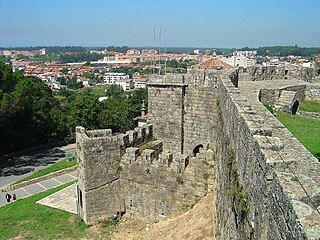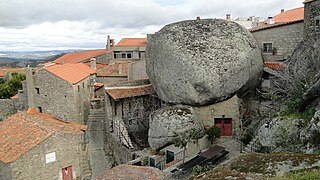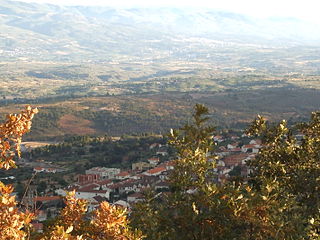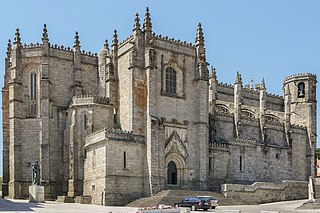
Viseu is a city and municipality in the Centro Region of Portugal and the capital of the district of the same name, with a population of 100,105 inhabitants in the entire municipality, and center of the Viseu Dão Lafões intermunipical community, with 267,633 inhabitants.

Santa Maria da Feira is a city and a municipality in Aveiro District in Portugal, 23 km from central Porto. The population in 2011 was 139,309, in an area of 215.88 km².

Loriga is a civil parish and town in south-central part of the municipality of Seia, in central Portugal. Part of the district of Guarda, it is 20 km away from the city of Seia, 40 km away from Viseu, 80 km away from Guarda and 320 km from Lisbon, nestled in the Serra da Estrela mountain range. The population in 2011 was 1,053, in an area of 36.25 km2, including the two localities, the town of Loriga and the village of Fontão.
The following is a list of Portugal-related articles. Those interested in the subject can monitor changes to the pages by clicking on Related changes in the sidebar.

The Central Region or Central Portugal is one of the statistical regions of Portugal. The cities with major administrative status inside this region are Coimbra, Aveiro, Viseu, Caldas da Rainha, Leiria, Castelo Branco, Torres Vedras, Tomar, and Guarda. It is one of the seven Regions of Portugal. It is also one of the regions of Europe, as given by the European Union for statistical and geographical purposes. Its area totals 28,462 km2 (10,989 sq mi). As of 2011, its population totalled 2,327,026 inhabitants, with a population density of 82 inhabitants per square kilometre.

Felgueiras is a former civil parish in the municipality of Resende, Viseu District, Portugal. In 2013, the parish merged into the new parish Felgueiras e Feirão. In 2001, the population was 315 inhabitants occupying an area of 8.4 km².

Arganil is a town and municipality in Coimbra District, in Portugal. The population of the municipality in 2011 was 12,145, in an area of 332.84 km2. The present mayor is Luís Paulo Costa, elected by the Social Democratic Party. The municipal holiday is September 7.

Manteigas is a town and a municipality in Portugal. The population in 2011 was 3,430, in an area of 121.98 square kilometres (47.10 sq mi).

Fafe is a municipality in the northern Portuguese district of Braga. The population in 2021 was 48,502, in an area of approximately 219.08 square kilometres (84.59 sq mi). The city itself had a population of 15,703 in 2011. The present mayor is Antero Barbosa, elected by the Socialist Party. The municipal holiday is May 16.

Mangualde is a municipality in the subregion of Dão-Lafões, central region of Portugal. The population in 2011 was 19,880, in an area of 219.26 km2.

Fornos de Algodres is a municipality and a town in Portugal. The population in 2011 was 4,989, in an area of 131.45 km2. The municipality is located in Guarda District, Centro Region, Serra da Estrela Subregion. The present Mayor is Manuel Fonseca, elected by the Social Democratic Party. The municipal holiday is September 29.

Serra da Estrela Ski Resort is a ski resort located in a mountain range named Serra da Estrela, in the municipality of Seia, parish (freguesia) of Loriga, Portugal.

Guarda is a city and a municipality in the District of Guarda and the capital of the Beiras e Serra da Estrela sub-region in central Portugal. The population in 2021 was 40,126, in an area of 712.10 square kilometres (274.94 sq mi) with 31,224 inhabitants in the city proper in 2006. Founded by King Sancho I in 1199, Guarda is the city located at the highest altitude in Portugal and one of the most important cities in the Portuguese region of Beira Alta. Serra da Estrela, the highest mountain range in continental Portugal, is partially located in the district. The city is served by national and international trains on the Beira Alta and Baixa railway lines. The present mayor is Sérgio Costa, as an independent. The municipal holiday is November 27.
Bobadela is a former civil parish, located in the municipality of Boticas, Portugal. In 2013, the parish merged into the new parish Ardãos e Bobadela. It has a population of less than 487 inhabitants, occupying an area of 14.7 km2 in the northeast that extends into the Serra do Leiranco.

The Comunidade Intermunicipal das Beiras e Serra da Estrela is an administrative division in eastern Portugal. It was created in 2013. Since January 2015, Beiras e Serra da Estrela is also a NUTS3 subregion of Centro Region, that covers the same area as the intermunicipal community. The seat of the intermunicipal community is Guarda. Beiras e Serra da Estrela comprises parts of the former districts of Guarda and Castelo Branco. The population in 2011 was 236,023, in an area of 6,304.95 square kilometres (2,434.35 sq mi).

Girabolhos is a civil parish in the municipality of Seia, Portugal. The population in 2011 was 317, in an area of 17.88 km².


















